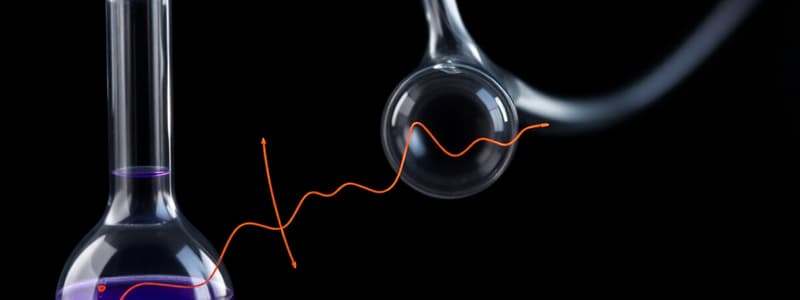Podcast
Questions and Answers
What is the average rate of change of [D] over the first 30 minutes?
What is the average rate of change of [D] over the first 30 minutes?
- +0.020 M/min (correct)
- -0.010 M/min
- -0.020 M/min
- +0.010 M/min
Which of the following statements about the rate of change is correct?
Which of the following statements about the rate of change is correct?
- The rate of change is always negative for products.
- The rate of change is always positive for reactants.
- The rate of change is always positive for products.
- The rate of change is always negative for reactants. (correct)
What is the relationship between the rate of consumption of Ag+(aq) and the rate of formation of [Ag(CN)2]−(aq)?
What is the relationship between the rate of consumption of Ag+(aq) and the rate of formation of [Ag(CN)2]−(aq)?
- The rate of consumption of Ag+(aq) is twice the rate of formation of [Ag(CN)2]−(aq).
- The rate of consumption of Ag+(aq) is half the rate of formation of [Ag(CN)2]−(aq).
- The rate of consumption of Ag+(aq) is equal to the rate of formation of [Ag(CN)2]−(aq). (correct)
- The rate of consumption of Ag+(aq) is four times the rate of formation of [Ag(CN)2]−(aq).
Which of the following is the correct expression for the instantaneous rate of change of D?
Which of the following is the correct expression for the instantaneous rate of change of D?
What is the relationship between the initial rates of A and D?
What is the relationship between the initial rates of A and D?
How does the rate of loss of CN−(aq) relate to the rate of loss of Ag+(aq)?
How does the rate of loss of CN−(aq) relate to the rate of loss of Ag+(aq)?
Why is it important to properly balance a chemical equation when determining relative rates?
Why is it important to properly balance a chemical equation when determining relative rates?
What is the difference between average rate and instantaneous rate?
What is the difference between average rate and instantaneous rate?
Flashcards
Chemical Kinetics
Chemical Kinetics
The study of reaction rates and how they change.
Rate of Change
Rate of Change
The speed at which a concentration of reactants or products changes over time.
Average Rate
Average Rate
The change in concentration over a designated time interval.
Instantaneous Rate
Instantaneous Rate
Signup and view all the flashcards
Rate of Formation
Rate of Formation
Signup and view all the flashcards
Rate of Consumption
Rate of Consumption
Signup and view all the flashcards
Relative Rates
Relative Rates
Signup and view all the flashcards
Balanced Chemical Equation
Balanced Chemical Equation
Signup and view all the flashcards
Study Notes
Chemical Kinetics: Reaction Rates
- Respect Colleagues: Turn off cell phones, put aside personal materials, and refrain from using electronic devices (iPods, laptops, PDAs) for non-class-related activities during lectures and recitations.
General Chemistry II (Chem 1780-1) - January 22, 2025
- Course: General Chemistry II (Chem 1780-1)
- Date: Wednesday, January 22, 2025
- Topic: Chemical Kinetics: Reaction Rates (Module 1)
- Subtopic: Reaction Rates
- Understanding the distinctions between rate of change, rate of consumption, and rate of formation.
- Calculating relative rates using balanced chemical equations.
- Next Topic: Kinetics: Rate laws; Method of Initial Rates
- Assessments: Lecture Questions (Canvas; Due Jan 25 at 11:59 pm). OWL-01 and 02 (Saturday; single session only).
Average Reaction Rates
- Definition: Average rate of change is calculated as the change in concentration over the change in time.
- For a reaction A → D
- Average rate of Change of D over first 30 minutes (Δ[D]/Δt) = +0.020 M/min
- Average Rate of Change of A: (Δ[A]/Δt) = −0.020 M/min (negative because A is consumed).
- Rate of Formation (Product): Positive (e.g., +0.020 M/min)
- Rate of Consumption (Reactant): Negative (e.g., -0.020 M/min)
Instantaneous Reaction Rates
- Definition: Instantaneous rate measures the reaction rate at a specific moment in time.
- Representation: It’s represented by the instantaneous slope of the concentration vs. time graph, calculated as the derivative (d[D]/dt).
- Positive slope D > 0: Formation of product.
- Negative slope A < 0: Consumption of reactant.
- Fastest rate: (time difference or dt) approaching zero (Δt → 0).
Relative Reaction Rates
- Balanced Reactions: Essential for calculating relative rates (e.g., aA + bB → dD + eE).
- Relationships: The relationship between the rates of consumption of reactants and the rates of formation of products are proportional to the stoichiometric coefficients in the balanced reaction.
- Example: In the reaction: Ag⁺(aq) + 2CN⁻(aq) → [Ag(CN)₂]⁻(aq)
- Rate of consumption of CN⁻(aq) = 2 * Rate of consumption of Ag⁺(aq)
- Relative Rates = − 1/1 Δ[A]/Δt = − 1/2 Δ[CN⁻]/Δt
Studying That Suits You
Use AI to generate personalized quizzes and flashcards to suit your learning preferences.




